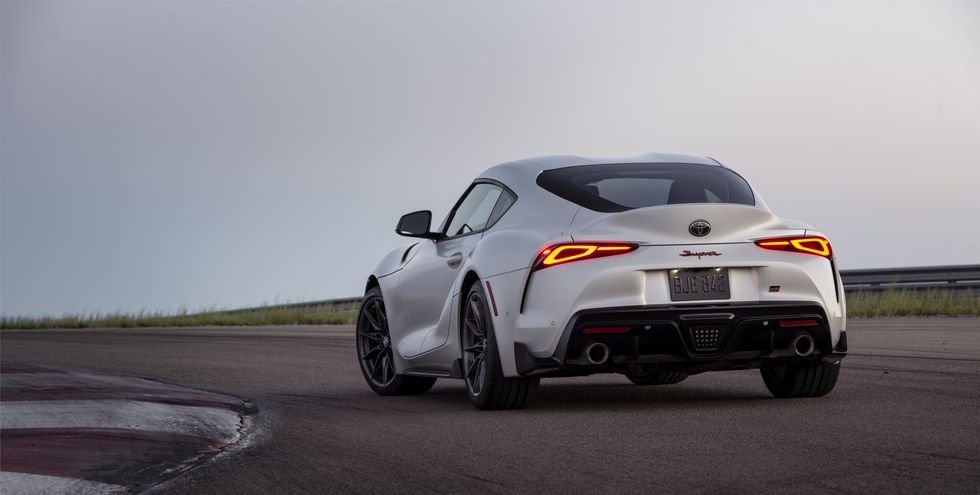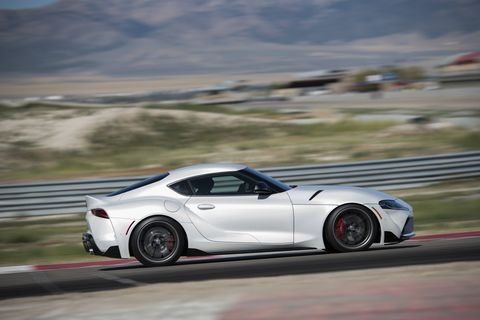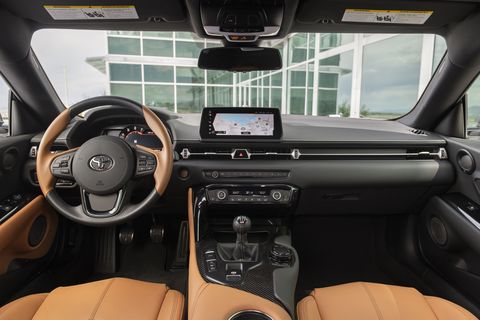I’ve driven the new Toyota Supra a handful of times, over thousands of miles. Yet every time I got out of one, after pressing the “Park” button on the top of its BMW-borrowed shifter, I felt disappointed. How much better could it have been if Toyota just put a little more love and care into its flagship sports car? The good news is that the Supra’s new manual transmission option alleviates much of that disappointment.
Since before the new Supra was officially revealed in January 2019, we’ve been asking Toyota what it would take for a manual transmission to become available. In April 2022, the automaker finally announced that our request, and that of enthusiasts everywhere, had been granted for 2023. A six-speed, row-your-own gearbox was officially on the way for the six-cylinder model. Even more good news, it’s a no-cost option on the $53,595 sports car.
I spent some time on track with the manual Supra at Utah Motorsports Park in late August. The new transmission is a game-changer.
It immediately feels reminiscent of a modern BMW’s manual, like those offered in the current-generation M3 and M4, but not a total clone. Though its short-travel, well-weighted clutch pedal is a BMW trademark, things are a bit different with the shift action. The six-speed’s unique shifter is surprisingly–and welcomingly–notchy on gear entry, and it’s a bit springy on its return to center. It’s not as hardcore or clicky as something like a Porsche GT car, but it’s easily the most satisfying manual Toyota offers right now. It’s also less numb than the unit in the M3 and M4.
This has also impacted gearing. The manual Supra has shorter gear ratios across the board, except for a taller final drive. Since our brief time in the car was spent on track, we can’t speak much for how well-suited the gearing is for daily driving or highway use. At this specific track, the manual Supra was happy to sit in third all day long when being pushed hard. Toyota says it bumped the final drive ratio to help improve acceleration. First gear goes to about 40, second tops out at nearly 70, then third is the goldilocks gear. With limited runway, it was hard to find the top of third, but it appears to be safely above 90 mph.
Though the manual Supra has a slower 0-60 time—4.2 seconds instead of the auto’s 3.9—the additional .3 seconds are a welcome tradeoff for the joy of manually notching the Supra from first to second after hitting its 7,000-rpm redline.
On top of all of that, the new manual won’t lock you out of gears on downshifts, like we’ve experienced with the automatic ZF eight-speed. Also, when you do go for a downshift, the pedals are well-suited for a heel-toe rev match, though Toyota’s “Intelligent Manual Transmission” auto rev-matching system is present and works just fine if you need the assist.
When talking with Toyota senior product planner Thomas Sondej, Jr., he stressed that the automaker didn’t just steal this gearbox from a BMW parts bin. According to Sondej, Toyota worked directly with ZF and “were heavily involved” to modify one of their existing units in a way that they thought fit the Supra best. Though it definitely feels familiar to recent manual BMWs, there are differences.
“Are we using parts that are in existence within the BMW Group? Absolutely,” Sondej told Road & Track. “But our engineers have increased the friction area and strengthened the diaphragm spring, they’ve modified an existing housing… They removed excess components that were not needed to reduce its weight. It truly is a GR-specific transmission for the GR Supra… How it shifts was taken [into consideration], the throw in the shift, the shift lever… it’s different. So you know, people always ask us what BMW car can we see the transmission in. You can’t because it’s a Supra transmission.”
Transmission aside, this is still a Supra. Though Toyota says it’s tweaked the suspension and chassis for the 2023 model year, the rear end is still weird. It’s soft and feels unsettled, like its rear wheels just want to hop around corners and over bumps. Though it remained safely planted during our track tests, it’s not a confident experience. The car and its Michelin Pilot Super Sports have impressive amounts of cornering grip, but the steering remains uncommunicative and numb—two things you don’t want in your sports car.
The 382-horsepower BMW-provided 3.0-liter inline-six, however, is strong as ever. Its 368 lb-ft of torque rips the Supra along with ease. It’s happy to be married to the ZF-sourced six-speed. I even enjoyed listening to its revs in the background of the audio notes I captured while driving the Supra on track.
The manual is a welcome adjustment to the A91 Supra. The ZF eight-speed automatic is a fine transmission, well-proven in other cars, but it doesn’t fit the enthusiast-friendly character Toyota is attempting to capture with the Supra. The six-speed manual doesn’t solve all the Supra’s issues, but it takes a car that could occasionally make the driver feel aloof and makes them a key part of the experience. That’s what really matters.










